The NVIDIA GeForce GTX Titan X Review
by Ryan Smith on March 17, 2015 3:00 PM ESTOverclocking
Finally, no review of a GTX Titan card would be complete without a look at overclocking performance.
From a design standpoint, GTX Titan X already ships close to its power limits. NVIDIA’s 250W TDP can only be raised another 10% – to 275W – meaning that in TDP limited scenarios there’s not much headroom to play with. On the other hand with the stock voltage being so low, in clockspeed limited scenarios there’s a lot of room for pushing the performance envelope through overvolting. And neither of these options addresses the most potent aspect of overclocking, which is pushing the entirely clockspeed curve higher at the same voltages by increasing the clockspeed offsets.
GTX 980 ended up being a very capable overclocker, and as we’ll see it’s much the same story for the GTX Titan X.
| GeForce GTX Titan X Overclocking | ||||
| Stock | Overclocked | |||
| Core Clock | 1002MHz | 1202MHz | ||
| Boost Clock | 1076Mhz | 1276MHz | ||
| Max Boost Clock | 1215MHz | 1452MHz | ||
| Memory Clock | 7GHz | 7.8GHz | ||
| Max Voltage | 1.162v | 1.218v | ||
Even when packing 8B transistors into a 601mm2, the GM200 GPU backing the GTX Titan X continues to offer the same kind of excellent overclocking headroom that we’ve come to see from the other Maxwell GPUs. Overall we have been able to increase our GPU clockspeed by 200MHz (20%) and the memory clockspeed by 800MHz (11%). At its peak this leads to the GTX Titan X pushing a maximum boost clock of 1.45GHz, and while TDP restrictions mean it can’t sustain this under most workloads, it’s still an impressive outcome for overclocking such a large GPU.
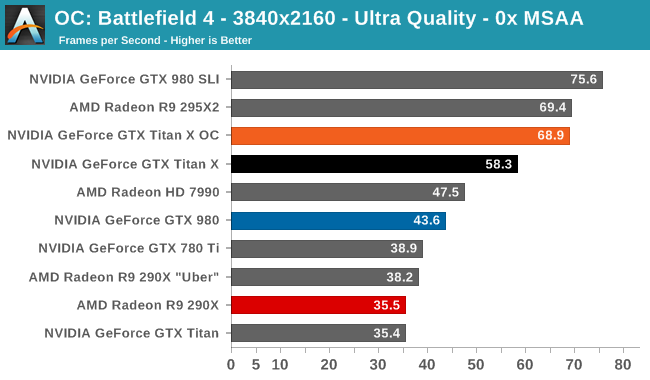

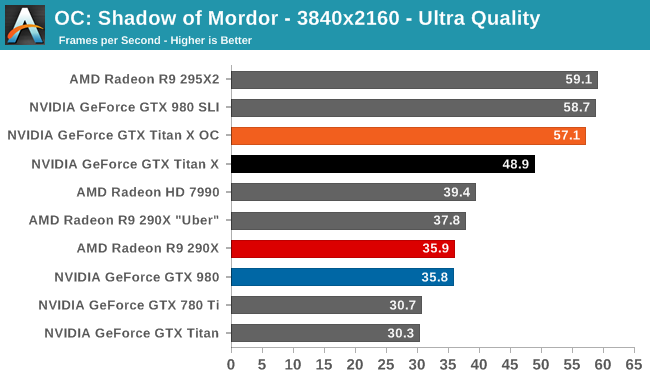
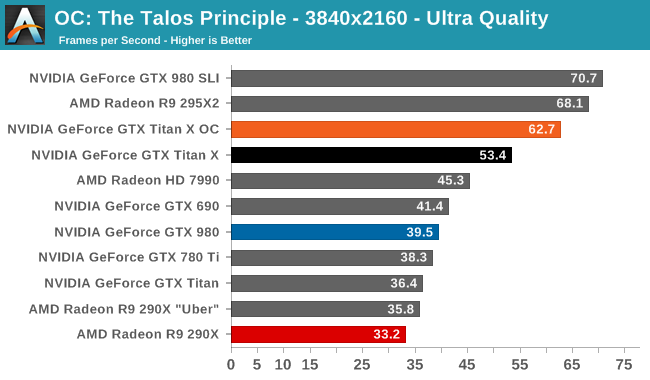
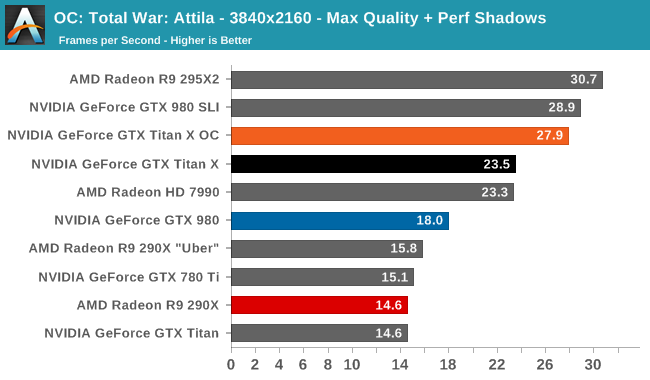
The performance gains from this overclock are a very consistent 16-19% across all 5 of our sample games at 4K, indicating that we're almost entirely GPU-bound as opposed to memory-bound. Though not quite enough to push the GTX Titan X above 60fps in Shadow of Mordor or Crysis 3, this puts it even closer than the GTX Titan X was at stock. Meanwhile we do crack 60fps on Battlefield 4 and The Talos Principle.
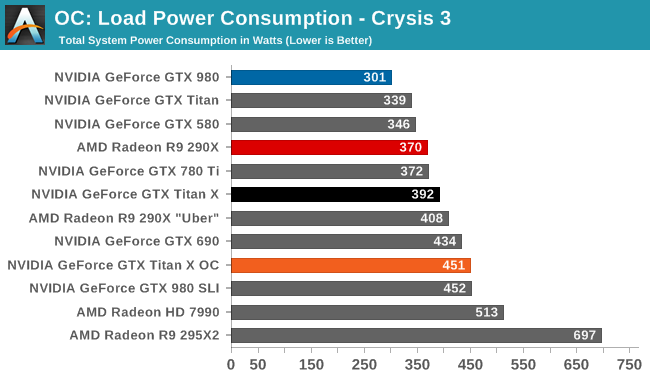
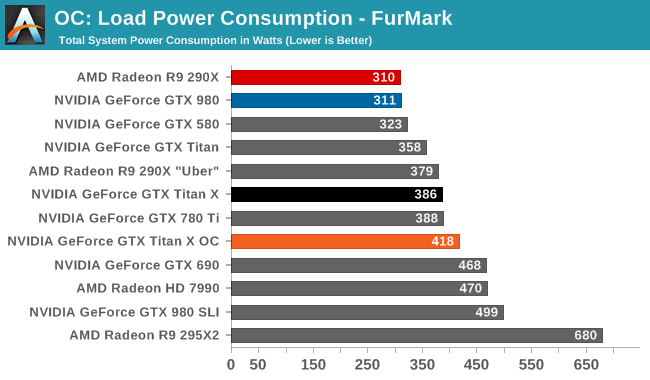
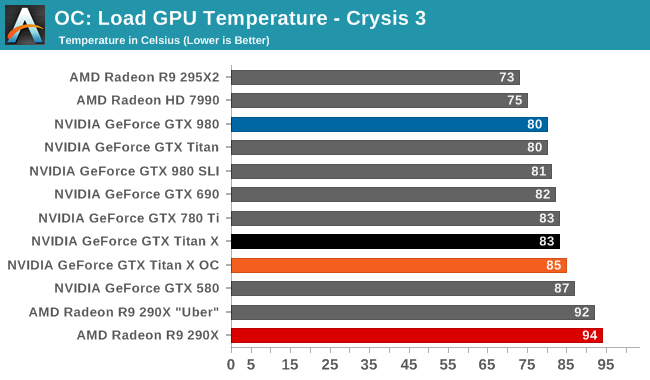
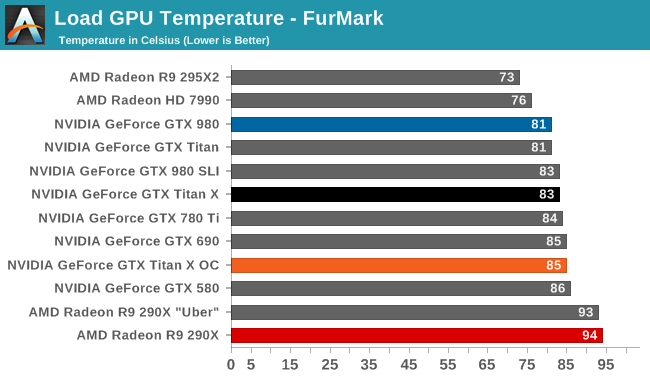
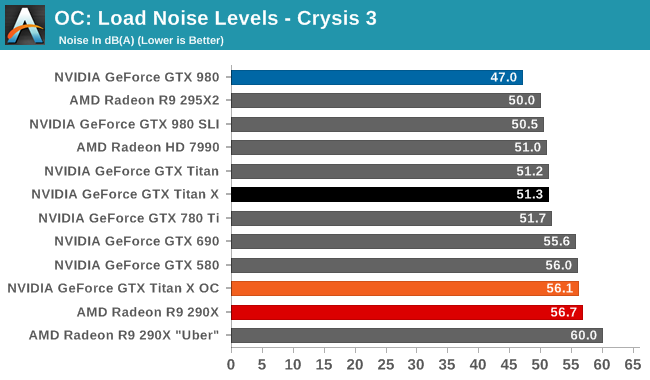

The tradeoff for this overclock is of course power and noise, both of which see significant increases. In fact the jump in power consumption with Crysis is a bit unexpected – further research shows that the GTX Titan X shifts from being temperature limited to TDP limited as a result of our overclocking efforts – while FurMark is in-line with the 25W increase in TDP. The 55dB noise levels that result, though not extreme, also mean that GTX Titan X is drifting farther away from being a quiet card. Ultimately it’s a pretty straightforward tradeoff for a further 16%+ increase in performance, but a tradeoff nonetheless.










276 Comments
View All Comments
stun - Tuesday, March 17, 2015 - link
I hope AMD announces R9 390X fast.I am finally upgrading my Radeon 6870 to either GTX 980, TITAN X, or R9 390X.
joeh4384 - Tuesday, March 17, 2015 - link
I do not think Nvidia will have that long with this being the only mega GPU on the market. I really wish they allowed partner models of the Titan. I think a lot of people would go nuts over a MSI Lightning Titan or something like that.farealstarfareal - Tuesday, March 17, 2015 - link
Yes, a big mistake like the last Titan to not allow custom AIB cards. Good likelihood the 390X will blow the doors off the card with many custom models like MSI Lightning, DCU2 etc.Also $1000 for this ??! lol is the only sensible response, none of the dual precision we saw in the original Titan to justify that price, but all of the price. Nvidia trying to cash in here, 390X will force them to do a card probably with less VRAM so people will actually buy this overpriced/overhyped card.
chizow - Tuesday, March 17, 2015 - link
Titan and NVTTM are just as much about image, style and quality as much as performance. Its pretty obvious Nvidia is proud of the look and performance of this cooler, and isn't willing to strap on a hunking mass of Al/Cu to make it look like something that fell off the back of a Humvee.They also want to make sure it fits in the SFF and Lanboxes that have become popular. In any case I'm quite happy they dropped the DP nonsense with this card and went all gaming, no cuts, max VRAM.
It is truly a card made for gamers, by gamers! 100% GeForce, 100% gaming, no BS compute.
ratzes - Tuesday, March 17, 2015 - link
What do you think they give up when they add DP? Its the same fabrication, was for titan vs 780ti. If I'm mistaken, the only difference between cards are whether the process screwed up 1 or more of the smps, then they get sold as gaming cards at varying decreasing prices...MrSpadge - Tuesday, March 17, 2015 - link
Lot's of die space, since they used dedicated FP64 ALUs.chizow - Wednesday, March 18, 2015 - link
@ratzes, its well documented, even in the article. DP/FP64 requires extra registers for the higher precision, which means more transistors allocated to that functionality. GM200 is only 1Bn more transistors than GK210 on the same process node, yet they managed to cram in a ton more functional units. Now compare to GM204 to GK204 3.5Bn to 5.2Bn and you can see, its pretty amazing they were even able to logically increase by 1.5x over the GM204, which we know is all gaming, no DP compute also.hkscfreak - Wednesday, March 18, 2015 - link
Someone didn't read...nikaldro - Tuesday, March 17, 2015 - link
fanboysm to the Nth p0waH..furthur - Wednesday, March 18, 2015 - link
which meant fuck all when Hawaii was released